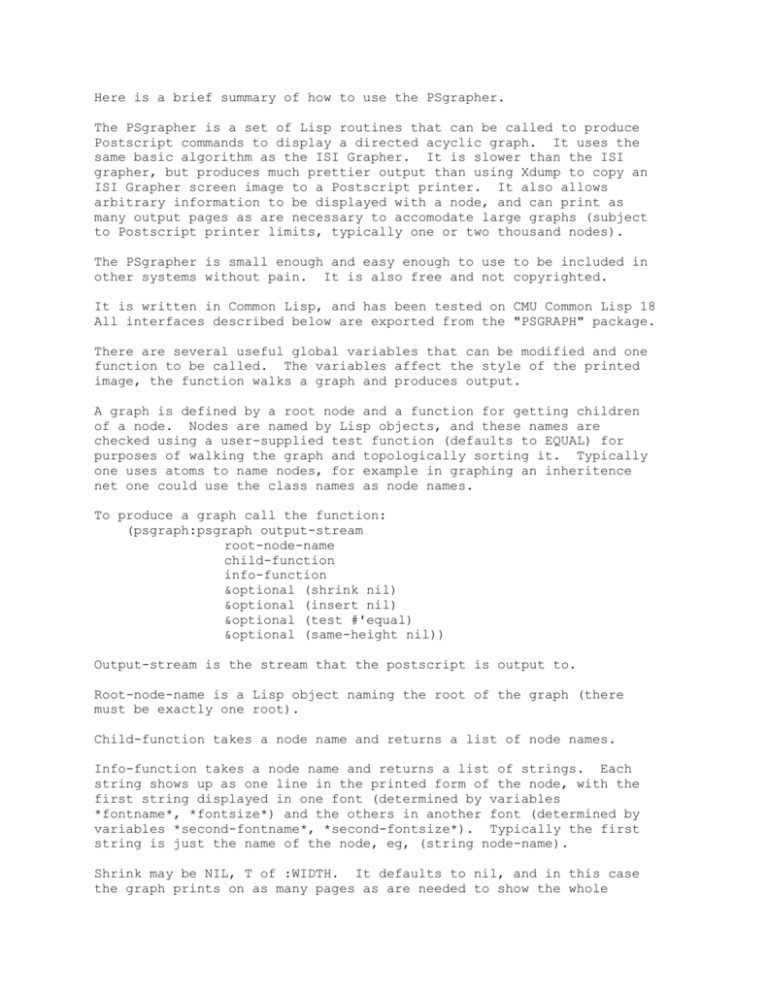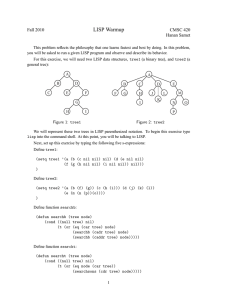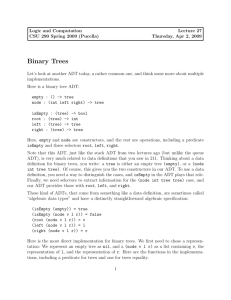psgraph - Common
advertisement

Here is a brief summary of how to use the PSgrapher. The PSgrapher is a set of Lisp routines that can be called to produce Postscript commands to display a directed acyclic graph. It uses the same basic algorithm as the ISI Grapher. It is slower than the ISI grapher, but produces much prettier output than using Xdump to copy an ISI Grapher screen image to a Postscript printer. It also allows arbitrary information to be displayed with a node, and can print as many output pages as are necessary to accomodate large graphs (subject to Postscript printer limits, typically one or two thousand nodes). The PSgrapher is small enough and easy enough to use to be included in other systems without pain. It is also free and not copyrighted. It is written in Common Lisp, and has been tested on CMU Common Lisp 18 All interfaces described below are exported from the "PSGRAPH" package. There are several useful global variables that can be modified and one function to be called. The variables affect the style of the printed image, the function walks a graph and produces output. A graph is defined by a root node and a function for getting children of a node. Nodes are named by Lisp objects, and these names are checked using a user-supplied test function (defaults to EQUAL) for purposes of walking the graph and topologically sorting it. Typically one uses atoms to name nodes, for example in graphing an inheritence net one could use the class names as node names. To produce a graph call the function: (psgraph:psgraph output-stream root-node-name child-function info-function &optional (shrink nil) &optional (insert nil) &optional (test #'equal) &optional (same-height nil)) Output-stream is the stream that the postscript is output to. Root-node-name is a Lisp object naming the root of the graph (there must be exactly one root). Child-function takes a node name and returns a list of node names. Info-function takes a node name and returns a list of strings. Each string shows up as one line in the printed form of the node, with the first string displayed in one font (determined by variables *fontname*, *fontsize*) and the others in another font (determined by variables *second-fontname*, *second-fontsize*). Typically the first string is just the name of the node, eg, (string node-name). Shrink may be NIL, T of :WIDTH. It defaults to nil, and in this case the graph prints on as many pages as are needed to show the whole thing. If shrink is T then the entire graph is squashed appropriately to fit on one page of output. If shrink is :width then the width of the graph is shrunk appropriately to fit across one page of output but print on as many pages as necessary to show the full height of the graph. Insert is a boolean. It defaults to nil, and in this case the generated Postscript file contains commands to print the output. If insert is t then the output file is always shrunk (shrink is t) and no commands are generated to print the page. This means the resulting file can be included in Scribe files, for example, and Scribe can decide when to print the page. Test is a function that return whether two nodes are the same. Same-height is a boolean. It defaults to Nil, and in this case the height of the node no large that necessary. If same-height is T the same height is used for all the nodes which can improve the balance of tree graphs. -=After loading psgraph, one can play with the various global variables, all of which have string values (except for the two font size variables). *fontname*, *fontsize*, *second-fontname*, *second-fontsize* are as described above. They default to "Helvetica" in 10 point and "Helvetica-Oblique" in 8 point, respectively. *boxgray* and *boxkind* determine how the boxes around nodes look. *boxkind* is either "fill" or "stroke", for solid or outline boxes, and *boxgray* is "0" for solid black, "1" for solid white, or in between. These default to ".2" and "stroke". Other variables: *max-psnodes* *extra-x-spacing* *extra-y-spacing* *edgewidth* *edgegray* *edgecap* *textgray* *pageheight* *pagewidth* *boxradius* *boxedge* *chunksize* Psgraph sends its output to the output-stream, so typically it is called from within (with-open-file ....). For example, one might use it like this: (load "psgraph") (setf psgraph:*boxkind* "fill") (setf psgraph:*boxgray* ".8") (setf psgraph:*fontsize* 8) (setf psgraph:*second-fontsize* 6) (defun children (x) (cond ((eq x 'A) '(B C D)) ((member x '(B C D)) '(E F G)) ((member x '(E F G)) '(H)) (t nil))) (defun info (x) (list (string x))) (defun graph (&optional (shrink t)) (with-open-file (output-stream "g.ps" :direction :output :if-exists :supersede) (psgraph:psgraph output-stream 'A #'children #'info shrink nil #'eq))) Another example: (defun code-graph-to-file (s file &optional shrink insert) (let ((psgraph:*fontname* "Times-Roman") (psgraph:*fontsize* 8) (psgraph:*second-fontname* "Times-BoldItalic") (psgraph:*second-fontsize* 6) (psgraph:*boxgray* "0") (psgraph:*edgegray* "0") (psgraph:*extra-x-spacing* 30)) (with-open-file (output-stream file :direction :output :if-exists :supersede) (psgraph:psgraph s #'psg-children #'psg-info shrink insert #'eq))))











